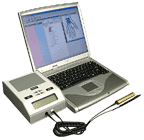

Electrodermal screening is based on a theoretical model by Japanese scientists and practical application by the German physician, Dr. Rheinhold Voll. Electrodermal screening describes the technique of using a low current to evaluate the electrical resistance of the body via acupressure point(s) which are part of the larger electromagnetic system of the body. These devices use a brass electrode (held in one hand) and a metal probe, held by the technician, which is then applied to specified point(s) on the person being tested (usually the index finger). The probe does not penetrate the skin and is used to apply approximately 0.9 volts of direct current to the area.
The ability of the body to react to this introduction of current is measured by the computer which is connected to this circuit created by the probe and brass electrode. The measurements are used to identify areas of possible stress to the body including foods, chemicals, inhalants or nutritional deficiencies and inflammation in tissues or organ systems. These imbalances are said to be detectable via electrodermal screening, but do not constitute a diagnosis, nor do they replace standard laboratory tests or physical exams. In the case of poor energy resistance, as detected by the electrodermal screening program (either Omega AcuBase or IQS), then the supplements or foods are also tested.
The initial appointment is a minimum of two hours in duration for the testing. At that time, the technician usually evaluates possible imbalances regarding environmental sensitivities including food, chemicals, inhalants or other possible causes of imbalance. Subsequent visits usually focus on possible imbalances of tissue or organ systems that may be detectable by electrodermal screening. Further visits are made to continue testing and follow your progress.
Risks of Electrodermal screening include possible discomfort at the site of probe placement where varying levels of pressure is intermittently applied (commonly on the index finger) Otherwise, there are no known side-effects or contra-indications associated with use of these instrument(s).